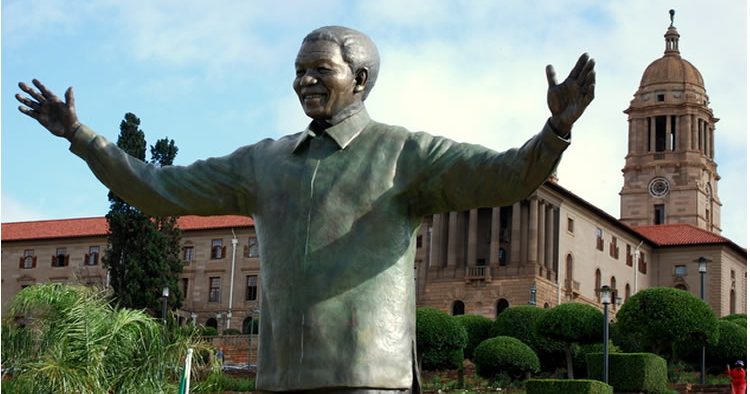Journeying to Pretoria
Share


Mandela Statue in front of the Union building
FUNKE OSAE-BROWN
The light rain shower of the previous day resulted in a rather chilly weather that made the body shiver this morning. The tall buildings at the Melrose Arch couldn’t contain the strong wind blowing across the area. Even the hot cups of coffee we gulped at breakfast did not help much. However, it was in this atmosphere that we found our way to the waiting coach on the other side of the street. We awaited the arrival of the other members of the group who were still busy at the breakfast table, and before long, we began the journey to Pretoria.
As we proceeded on our journey, beautiful landscapes with mountains serving as backdrops greeted our eyes. No doubt, I could have guessed that the sight would have inspired another masterpiece from Picasso!
In the city centre of Pretoria, we moved through many streets, leaving notable departmental stores like Shoprite and the famous Woolworth behind us as we navigated towards the Union building, Pretoria’s most famous landmark.
The Union Building is situated on Meintjeskop, the highest point of old Pretoria. It symbolises the authority of the state and the status of Pretoria as the headquarters of the national government. Greg of Bophelo Tours, our guide, later explains to us that Meintjeskop is situated on the eastern boundary of Elandsfontein, one of the two farms on which Pretoria was originally established in 1855.
“The farm belonged to President Wessel Pretorius, after whom the city was named,” explained Greg, our tour guide. “Pretorius sold the portion of the farm on which the Union Buildings stand to Andries Francois du Toit, Pretoria’s first magistrate, who sold the land to Stephanus Jacobus Meintjes, after whom Meintjeskop was named.”

The design of the Union Building is breathtaking
The design of the Union Building is breathtaking. Right in front of the building, to the left, is an expansive garden that is neatly mowed and kept. Few people were lying on the lush carpet grass, basking in the rays of the sun. A few metres further down, a couple and their bridal train were engrossed in a photo shooting session. “Sorry we are barging in on your wedding,” says Tsholofelo Mogale of South African Tourism, as we walked towards the newly-weds, full of admiration. But there was no response from the train, who were rather overjoyed to notice the rude interruption.
A few minutes later, we returned to the Union Building to admire its magnificent heights with the Torch of Peace burning brightly in front of it. The Union Building was built to house the government departments of the new union of South Africa in 1910, and is one of Sir Hebert Baker’s finest designs.
Greg also told us that the much-admired garden was designed by Baker as a public park, modelled on those of the famous Villa d’Este at Tivoli near Rome in Italy. From Church Street, we look over the wide expanse of lawns bounded on the east and west by tall avenues that slope to the public road which traverses the length of the buildings. This road meanders up the western slope from the city in easy curves, which makes us have a glimpse of the building from different angles as we proceed up the hill.
As we looked keenly at the brownish building, we realised that the redstones, columns and walls are even more smoothly finished, and the craftsmanship displayed in the stonework shows a perfection which one may say the work of any artist has not achieved before. From the Union Building, the coach meanders towards the Church Square, which is a beehive of activities when we arrive. Families, little boys and girls, middle-aged men and women are all over the place, taking photographs, chatting, exchanging pleasantries or relaxing on the lush grass. A small group of people cluster around because it is a beautiful way to relax at midday on a Friday.

We had a glimpse of the building from different angles as we proceeded up the hill.
The imposing statue of Paul Kruger is unmistakable in the park. The statue was completed by the famous sculptor, Anton van Wouw. Kruger was a former president of South Africa. His term in office coincided with the discovery of gold on the Witwatersrand in 1886, which led to an influx of foreign fortune-seekers and miners, and eventually the outbreak of the Anglo-Boer war in 1899. The statue was completed in 1899, and only arrived in Maputo after the outbreak of the war, where it remained until after the war. It was eventually erected in the Prince’s park, Church Street West, in 1913. But in 1925 I was moved and erected in front of the Pretoria Railway Station before it was finally brought to the Church Square in 1954. This incessant movement of the statue explains the blisters which now cover it.





